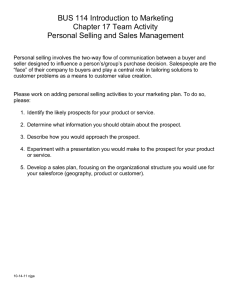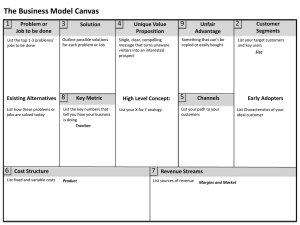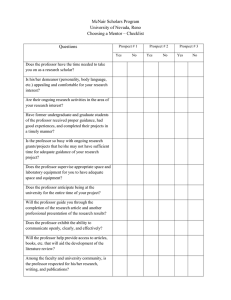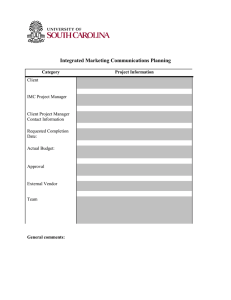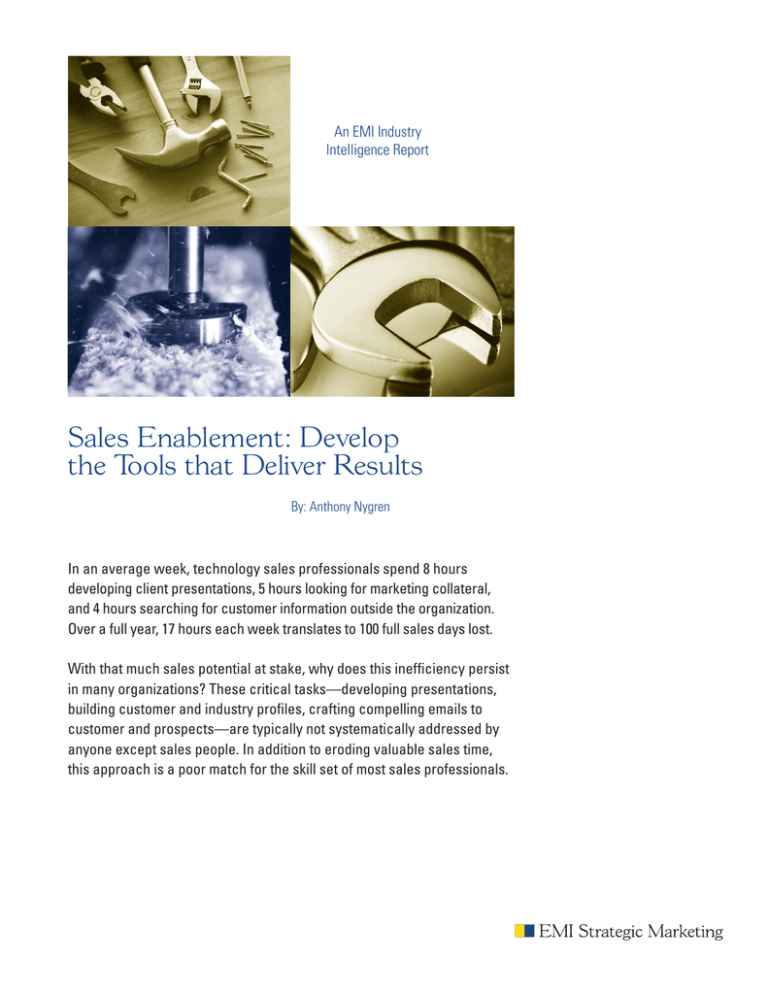
An EMI Industry
Intelligence Report
Sales Enablement: Develop
the Tools that Deliver Results
By: Anthony Nygren
In an average week, technology sales professionals spend 8 hours
developing client presentations, 5 hours looking for marketing collateral,
and 4 hours searching for customer information outside the organization.
Over a full year, 17 hours each week translates to 100 full sales days lost.
With that much sales potential at stake, why does this inefficiency persist
in many organizations? These critical tasks—developing presentations,
building customer and industry profiles, crafting compelling emails to
customer and prospects—are typically not systematically addressed by
anyone except sales people. In addition to eroding valuable sales time,
this approach is a poor match for the skill set of most sales professionals.
Among your company’s best salespeople,
how many are very good at…
• Synthesizing large volumes of competitive information to find
key differentiators?
• Writing nuanced, concise, targeted emails?
• C omposing sales presentations that are consistent with brand
positioning and also compelling decision motivators?
• Articulating consistently the differentiating benefits of a product/service?
Despite the poor fit with their skill set—and the value of developing effective
modular arsenals of these tools for reuse across the sales teams—these tasks
are too often left to sales, because marketing does not recognize this work as
important. The result? Inefficiency and lower conversion rates.
Optimizing selling time requires an investment in tools that enable rapid response
to maintain sales momentum, and that bolster the personal touch of sales with
customized, strategic, compelling messaging. This paper describes several vital
tools that, when properly designed, executed, and deployed, increase active selling
time, improve message consistency and effectiveness, and decrease new hire
ramp-up time.
An EMI Industry Intelligence Report
1
Filling the Tool Box
Tool: Email Templates
Personalized, customized emails are important vehicles for moving an opportunity
deeper in the sales cycle. To be effective, however, they must be targeted at a
specific moment in the sales.
• If a sales person has just gotten off the phone with a new prospect, the
email needs to offer a next step, shaping the seller’s action plan and
overcoming prospect inertia.
• If a new product or service has just been introduced, an email should offer
opportunities to learn more and a clear expectation for the next sales outreach.
• If a prospect is hesitant, the email needs to offer a compelling reason to
act or overcome the potential objections.
Email templates address these needs, but also offer two important benefits
over ad hoc emails. First, the templates ensure that prospects are receiving
communications that are consistent and compelling, as well as free of typos,
poor grammar, and unpolished language. Second, the templates save time: while
it doesn’t take a tremendous amount of time to write a single email, even a few
minutes per email adds up when multiplied by 5, 10, or 20 emails per day.
Moreover, sending emails immediately after first contact with a prospect actually
leads to more closed sales than spending a week or two crafting a customized
email; email templates facilitate this quick response.
Benefits scripts
offer the sales
person a strong,
reliable foundation
for capturing
the opportunity.
Tool: Benefits Scripts
The first presentation of benefits is a key juncture in the sales cycle, determining the
prospect’s motivation to continue the conversation and shaping their interest and
commitment. To avoid undermining the opportunity, the initial communication must be:
• Convincing
• Responsive to the prospect’s needs
• Compelling
Sales people often recite features rather than presenting benefits. In many cases,
even when benefits are presented, they are often monochromatic, rather than
colored to match a prospect’s needs. And, as new sales people ramp up, they
typically learn by imitating their more experienced peers, which means they
perpetuate that approach, for better or for worse.
While fully scripted sales discussions are a recipe for failure, benefits “talking
points” and needs triggers can guide a sales person to better and faster results.
Moreover, modular scripts can be developed to fit a range of sales scenarios—
first meeting, objection handling, consideration versus competition—and
to target different buyer types. Benefits scripts shorten the sales cycle and
improve onboarding efficiency by enabling sales people of any experience
level to present benefits that are consistent, on brand, strategically sound,
and competitively positioned.
2
An EMI Industry Intelligence Report
Tool: Competitive Silver Bullets
Unless a sales person is in the enviable position of being a sole-source solution,
comparison to the competition (including internal resources or the status quo) is
inevitable. Handled effectively, explicit competitive comparisons can winnow the
field of competitors, demonstrate expertise and knowledge of customers’ needs,
and accelerate the close. Handled ineffectively, it can create confusion, focus
attention on details that don’t differentiate, and actually prolong the sales cycle
by leading prospects to clarifying conversations with other vendors.
The first step in handling a competitive comparison effectively is to define the
terms of the comparison in a way that is logical and plausible, resonates with
the prospect’s needs, and positions the sales person’s offering favorably. Once
these criteria have been applied to define the vectors, the comparison needs
to be fair and accurate for it to have an impact. Developing the comparisons
ahead of time, buttressing them with third-party references and objective
assessments—and ideally, enabling access to the comparisons during prospect
discussions—guarantee effectiveness. Investing in the development and
continuous maintenance of the comparisons improves sales productivity and
delivers accurate, current content. Arming sales people with these comparisons
improves conversion rates not only by demonstrating competitive superiority, but
also by building confidence in the sales person’s industry expertise.
A database or
worksheet of competitive
comparisons that
enables quick and
easy reference equips
sales people for success
in competitive situations.
Tool: Presentation Templates and Automated Proposal Builders
The sales presentation is often the single most important interaction in the sales
cycle; it is always the moment when the seller has an opportunity to formally
summarize benefits, terms, and ROI for the prospect. It is vital to use this window
of opportunity to offer the buyer a compelling and consistent reason to buy and
to make a commitment immediately. Development of a compelling and effective
presentation is time-consuming. Capturing and organizing customer information
and benefits case; creating a logical, compelling flow; ensuring that the customer
data and preferences are correct—all of these activities can consume significant
sales time. And the less experienced the sales person, the more these issues
are magnified.
Templates and proposal automation remove most of these challenges. They
eliminate anxieties about grammar, spelling, and factual errors that can
significantly disrupt a presentation and can undermine a prospect’s confidence.
Automating and standardizing all non-value added, non-individualized content
reduces the time it takes the sales person to create the presentation, as well as
the time between sales interactions. Finally, templates and proposal automation
guarantee consistency of message, language, and appearance, in addition to ensuring
that the presentation contains a well-crafted, strategic set of key selling points.
An EMI Industry Intelligence Report
3
Tool: Sales Campaign Kits
Across industries, the trend is towards a more consultative selling, but sales
campaigns remain a compelling approach to focusing sales activity and
accelerating sales growth. Whether launching a new product or driving cross-sell
are the goals, sales teams need to be trained and armed with materials that they
need to close the deals. Incentives, while important, are not enough. Time-bound,
focused sales sprints are effective when they combine consultative selling tools,
lead generation marketing, and competition for incremental reward.
Sales campaign kits raise the performance of the sales team by delivering tools
to simplify selling and motivate greater effort. Kits can contain everything from
prospect diagnostics to quick reference guides to motivational messaging and
award opportunities. These tools deliver results by reducing the variability of
sales people’s product knowledge, providing door-opening techniques and objection
handling strategies, and driving top-of-mind awareness of the product(s)
featured. In our experience, well-designed sales campaigns can deliver a 3 to 7%
boost in the performance of the large population of sales people in the middle
of the performance bell curve. For the higher-performing tiers, campaigns have
delivered a up to a 50% increase in sales.
The Tool Box On-Site:
Examples from the Field
The following case studies illustrate how companies used sales toolkit
components to drive sales success.
Example: Market-leading software company pursuing fast growth
A leading provider of software to a segment of the SMB market was
forecasting 30% annual growth but faced a dilemma: having optimized their
marketing strategy and tactics to increase leads by over 100%, how could
they convert those new leads to deliver on growth goals without a significant
investment in additional sales resources? In addition, how could the company
ensure that any new sales hires that were brought on would be fully
ramped-up as quickly as possible?
Operationally, leads generated by marketing were distributed to sales people,
who were then tasked with managing the opportunity, with a high degree of
autonomy. While a few email templates had been created, they were long, not
on-message, and not tailored to different stages in the lead management process.
Moreover, new hires modeled their selling techniques on the existing examples;
they adopted and adapted old presentations for their own sales opportunities,
and copied and modified old emails to send to their clients.
An EMI Industry Intelligence Report
4
The solution for the software company was to invest time and resources in
developing a suite of sales tools to enable them to more efficiently move
prospects along the sales cycle. The tools included:
• A standard sales presentation template for online demonstrations that
contained slides highlighting the key differentiators for the company
• A set of emails targeted at specific industries and specific points in the
buying cycle
• A collection of competitor comparison sheets both to be used by sales on
calls and to be sent to prospects
The result of these efforts was a much more efficient sales force—one that was able
to deliver a 40% increase in revenue with only a 25% increase in sales resources.
Example: Leading bank seeking to improve sales productivity
A leading U.S. bank had implemented a new salesforce automation (SFA)
system, but found that its sales force was not entering their pipeline data
into the new tool, thus eroding its value and compromising sales management
effectiveness. In addition, teams were spending an average of 3 to 5 hours
per week in proposal and presentation development. A survey of presentations
and proposals developed demonstrated a lack of consistency, accuracy,
and effectiveness.
To address this issue, EMI created a modular proposal and presentation tool,
which included:
• A customizable document generator using Siebel and Microsoft Word
• A customer needs diagnosis tool linked to more than 30 products, enabling
easy, effective and compliant industry and client customization
To support the deployment of the proposal tool, EMI created and implemented
a field-driven training program.
Following the launch of the proposal tool, bank regions reported 20 to 50%
increased proposal use, average proposal and presentation development time
fell to under an hour, and the bank generated higher close rates.
An EMI Industry Intelligence Report
5
A Blueprint for Tool Building
As evidenced by the discussion and examples above, each one of the tools has
a “sweet spot” in the sales cycle—a point at which it’s likely to be used most
often and most effectively—based on its intended use. Recognizing these tool
“sweet spots” can be valuable when making decisions about investing resources.
An audit of sales operations and performance data should reveal the points of
greatest weakness in the status quo. A logical approach would be to target
these points of weakness first with the appropriate tools, then work to fill out
the portfolio.
Deployment “Sweet Spot”
Tool
Email templates
Benefits scripts
Prospecting
Opportunity Dev.
Close
•
•
•
•
•
•
•
•
•
• Primary
• Secondary
Competitor product/
service comparison
Presentation template/
proposal builder
Sales campaign kits
Strategic sales tools
can magnify the ROI
on both marketing
dollars and sales hours.
•
•
•
Just building the tools will not, in and of itself, deliver results. If sales does not
embrace and use the tools, any investment in their development will have been
wasted. Sales must be involved throughout the development process to enable
effective design and ensure executive endorsement, and a focused, disciplined
training program must be applied to roll out a new suite of sales tools.
These tools complement, but do not replace, SFA or lead nurturing software
solutions. By creating efficiencies to speed effective handling of sales opportunities,
and enabling more effective messaging and marketing by each sales person
at the front line, these tools both increase sales activity and improve close
rates. By bringing the best of marketing into the most important active-selling
moments, strategic sales tools can magnify the ROI on both marketing dollars
and sales hours.
An EMI Industry Intelligence Report
6
Conclusion
For many companies, sales enablement tools like those described
previously are considered afterthoughts by marketing and sales
management—the ad hoc work addressed by overstretched
resources whenever they have time. Unlike a sales force that’s too
small or less capable, or a marketing effort that misses key potential
customers, the lack of these tools often goes unnoticed; the ROI
on the creation of the tools seems hard to quantify. But the reality,
as our examples point out, is that ignoring or under-investing in
these tools erodes sales results. Without a best-in-class suite
of sales tools, selling time is lost, interactions with prospects
are sub-optimal, and competitive advantages are left unstated.
With them, sales cycles are shortened, sales productivity is
magnified, new hire ramp-up is accelerated, and sales conversion
rates are increased.
15 Broad Street, Boston, MA 02109
emiboston.com w 617-224-1101
About the Author
Anthony Nygren is Vice President at
EMI Strategic Marketing
About EMI
EMI has been working with Fortune 500
companies and financial services leaders
to drive results through our clients’ sales
and service channels. For more than 20
years, our strategic programs, combined
with our industry expertise, have helped
companies achieve greater growth and
increased customer loyalty.
To learn more about what EMI can do for
your company, call 617-224-1101 or visit
us on the web at emiboston.com.
© 2011 EMI Strategic Marketing
All Rights Reserved
emi110105


